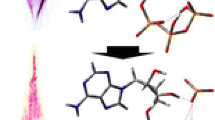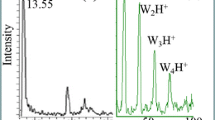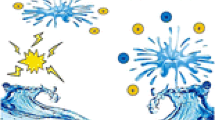Abstract
Electrospray ionization (ESI) mass spectrometry (MS) has been used in conjunction with computer modeling to investigate binding tendencies of alkali metal cations to low molecular weight solvents. Intensities of peaks in ESI mass spectra corresponding to solvent-bound alkali metal cations were found to decrease with increasing ionic radii (Li+ > Na+ > K+ > Cs+) in either dimethylacetamide (DMAc) or dimethylformamide (DMF). When a lithium or sodium salt was added to an equimolar mixture of DMF, DMAc, and dimethylpropionamide (DMP), the intensities of gas-phase [solvent + alkali cation]+ peaks observed in ESI mass spectra decreased in the order DMP > DMAc ≫ DMF. A parallel ranking was obtained for alkali metal cation affinities in ESI-MS/MS experiments employing the kinetic method. These trends have been attributed to a combination of at least three factors. An inductive effect exhibited by the alkyl group adjacent to the carbonyl function on each solvent contributes through-bond electron donation to stabilize the alkali metal cation attached to the carbonyl oxygen. The shift in the partial negative charge at the oxygen binding site with increasing n-alkyl chain length (evaluated via computer modeling), however, cannot fully account for the mass spectrometric data. The increasing polarizability and the augmented ability to dissipate thermal energy with increasing size of the solvent molecule are postulated to act in conjunction with the inductive effect. Further evidence of these contributions to solvent–cation binding in ESI-MS is given by the relative intensities of [solvent + Li]+ peaks in mixtures containing equimolar quantities of alcohols, indicating preferential solvation of Li+ in the order n-propanol > ethanol > methanol. These experiments suggest a combined role of polarizability, the inductive effect, and solvent molecule size in determining relative intensities of solvated cation peaks in ESI mass spectra of equimolar mixtures of homologous solvents.
Similar content being viewed by others
References
Austin, P. R. U. S. Patent 4,059,457 (1977).
McCormick, C. L. U. S. Patent 4,278,790 (1981).
Turbak, A. L.; El-Kafrawy, A.; Snyder F. W., Jr.; Auerbach, A. B. U. S. Patent 4,352,770 (1982).
Striegel, A. M.; Timpa, J. D. Carbohydr. Res. 1995, 267, 271–290.
Striegel, A. M.; Timpa, J. D. Int. J. Polym. Anal. Charac. 1996, 2, 213–220.
Striegel, A. M.; Timpa, J. D. In Strategies in Size Exclusion Chromatography; Potschka, M.; Dubin, P. L., Eds.; ACS Symposium Series 635; American Chemical Society, Washington, D. C., 1996, pp 366–378.
El-Kafrawy, A. J. Appl. Polym. Sci. 1982, 27, 2435–2443.
Rao, Ch. P.; Balaram, P.; Rao, C. N. R. J. Chem. Soc. Faraday Trans 1 1980, 76, 1008–1013.
Panar, M.; Beste, L. F. Macromolecules 1977, 10, 1401–1406.
Marcus, Y. In Ion Solvation; Wiley: New York, 1985; Chap 6, pp 130–183.
McLuckey, S. A.; Cameron, D.; Cooks, R. G. J. Am. Chem. Soc. 1981, 103, 1313–1317.
Cooks, R. G.; Patrick, J. S.; Kotiaho, T.; McLuckey, S. A. Mass Spectrom. Rev. 1994, 13, 287–339.
Cooks, R. G.; Wong, P. S. H. Acct. Chem. Res. 1998, 31, 379–386.
Bojesen, G.; Breindahl, T.; Andersen, U. N. Org. Mass Spectrom. 1993, 28, 1448–1452.
Cerda, B. A.; Wesdemiotis, C. J. Am. Chem. Soc. 1996, 118, 11884–11892.
Morisaki, N.; Inoue, K.; Kobayashi, H.; Shirai, R.; Morisaki, M.; Iwasaki, S. Tetrahedron 1996, 52, 9017–9024.
Wolf, R.; Grützmacher, H. F. New J. Chem. 1990, 14, 379–382.
Striegel, A. M.; Timpa, J. D.; Piotrowiak, P.; Cole, R. B. Int. J. Mass Spectrom. Ion Processes 1997, 162, 45–53.
Allen, M. A.; Vestal, M. L. J. Am. Soc. Mass Spectrom. 1992, 3, 18–26.
Morrison, R. T.; Boyd, R. N. Organic Chemistry 5th ed.; Allyn and Bacon: Boston, 1987; pp 229–232.
Handbook of Chemistry and Physics, 71st ed., Lide, D. R., Ed.; CRC: Boca Raton, FL, 1990.
Cotton, F. A.; Wilkinson, G. Advanced Inorganic Chemistry 5th ed.; Wiley: New York, 1988; p 124.
Liou, C. C.; Brodbelt, J. S. J. Am. Soc. Mass Spectrom. 1992, 3, 543–548.
Wu, c. N. Modern Organic Chemistry, Vol. 1; Barnes & Noble, New York, 1979; pp 46–47.
Taft R. W. In Progress in Physical Organic Chemistry, Vol. 14; Taft, R. W., Ed.; Wiley: New York, 1983, pp 247–350.
Taft, R. W.; Taagepera, M.; Abboud, J. L. M.; Wolf, J. F.; DeFrees, D. J.; Hehre, W. J.; Bartmess, J. E.; McIver, R. T. J. Am. Chem. Soc. 1978, 100, 7765.
Lowry, T. H., Schueller-Richardson, K. Mechanism and Theory In Organic Chemistry, 3rd ed; Harper and Row: New York, 1987, p 152.
Author information
Authors and Affiliations
Corresponding author
Rights and permissions
About this article
Cite this article
Striegel, A.M., Piotrowiak, P., Boué, S.M. et al. Polarizability and inductive effect contributions to solvent–cation binding observed in electrospray ionization mass spectrometry. J Am Soc Mass Spectrom 10, 254–260 (1999). https://doi.org/10.1016/S1044-0305(98)00140-8
Received:
Revised:
Accepted:
Issue Date:
DOI: https://doi.org/10.1016/S1044-0305(98)00140-8




